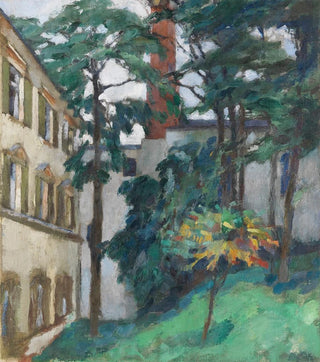Art print | Cour du château - Leo Putz


View from behind

Frame (optional)
In the fascinating world of art, some works manage to capture the essence of a place, a moment, or an emotion in such a poignant way that they become timeless. "Cour du château - Leo Putz" is one of those pieces that evoke an atmosphere of serenity and elegance. Entering Putz's pictorial universe, the viewer is immediately transported to an enchanting setting, where light and shadow dance harmoniously on stone walls. This art print invites contemplation, offering a pause amid the hustle and bustle of daily life, providing a glimpse of a peaceful life within a majestic castle. The choice of colors, the delicacy of details, and the skillfully orchestrated composition all testify to the undeniable talent of the artist.
Style and uniqueness of the artwork
Leo Putz's style is distinguished by his ability to blend realism with impressionist sensitivity. In "Cour du château," he manages to capture not only the imposing architecture of the building but also the surrounding atmosphere. The shades of green in the trees, the play of light on the walls, and the subtle presence of human figures add a lively dimension to the scene. Each element is treated with meticulous care that reveals the soul of the place, transforming a simple courtyard into a vibrant space of history and memory. The way Putz uses colors to create shadows and reflections gives the art print a depth that draws the eye and invites prolonged exploration. This blend of precise details and a certain fluidity in forms gives the piece a singularity that makes it unforgettable.
The artist and his influence
Leo Putz, born in 1869, was a painter whose work is rooted in the modern art movement. His training at the Academy of Fine Arts in Munich allowed him to acquire a technical mastery reflected in each of his works. Putz was able to draw inspiration from the great masters while developing a personal style that is uniquely his own. His travels across Europe, notably in Italy, enriched his palette and artistic vision. The influence of impressionism is palpable in his approach.

Matte finish

View from behind

Frame (optional)
In the fascinating world of art, some works manage to capture the essence of a place, a moment, or an emotion in such a poignant way that they become timeless. "Cour du château - Leo Putz" is one of those pieces that evoke an atmosphere of serenity and elegance. Entering Putz's pictorial universe, the viewer is immediately transported to an enchanting setting, where light and shadow dance harmoniously on stone walls. This art print invites contemplation, offering a pause amid the hustle and bustle of daily life, providing a glimpse of a peaceful life within a majestic castle. The choice of colors, the delicacy of details, and the skillfully orchestrated composition all testify to the undeniable talent of the artist.
Style and uniqueness of the artwork
Leo Putz's style is distinguished by his ability to blend realism with impressionist sensitivity. In "Cour du château," he manages to capture not only the imposing architecture of the building but also the surrounding atmosphere. The shades of green in the trees, the play of light on the walls, and the subtle presence of human figures add a lively dimension to the scene. Each element is treated with meticulous care that reveals the soul of the place, transforming a simple courtyard into a vibrant space of history and memory. The way Putz uses colors to create shadows and reflections gives the art print a depth that draws the eye and invites prolonged exploration. This blend of precise details and a certain fluidity in forms gives the piece a singularity that makes it unforgettable.
The artist and his influence
Leo Putz, born in 1869, was a painter whose work is rooted in the modern art movement. His training at the Academy of Fine Arts in Munich allowed him to acquire a technical mastery reflected in each of his works. Putz was able to draw inspiration from the great masters while developing a personal style that is uniquely his own. His travels across Europe, notably in Italy, enriched his palette and artistic vision. The influence of impressionism is palpable in his approach.






